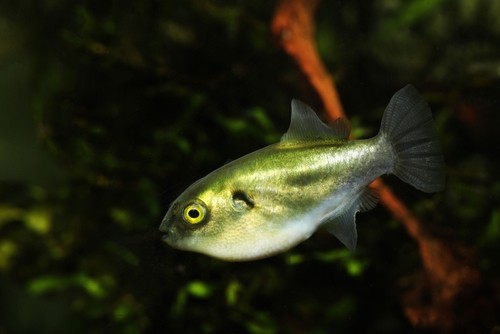Pufferfish, the charismatic acrobats of the aquatic world, captivate the imagination with their inflatable antics and enchanting appearances. They are popular choices for experienced aquarists and can be a bit difficult to care for.
Choosing the right tankmates for your pufferfish can be challenging. So, in this guide, we’ve done meticulous research and collected the top 15 puffer fish tank mates you can have in your tank.
Read on to find out more!
Contents
Puffer Fish Tank Mates – What You Need to Know
When choosing tankmates for pufferfish, there are several factors you should consider to avoid any conflicts or other problems between different species in your aquarium. Below, we mention 4 important specifications for pufferfish so that you can choose tankmates that have the same characteristics:
Temperament
Pufferfish are known to be temperamental and can attack other fish. Some species, however, are more peaceful.
Size
Pufferfish can range from 2 inches to 2 feet in length, depending on the species.
Competition
These fish are solitary and tend to prefer their own space. However, they can exhibit aggressive behavior if they feel threatened or if their territory is invaded.
Parameters & Tank Setup (freshwater puffers)
- pH range: 7.0 to 7.6
- dKH: 8 to 12
- temperature: 74 to 78 degrees Fahrenheit
- minimum tank size: 10 gallons (pea puffer) to 500 gallons (MBU puffer)
Top 15 Puffer Fish Tankmates
You also don’t want to miss these other related posts:
1. Otocinclus Catfish
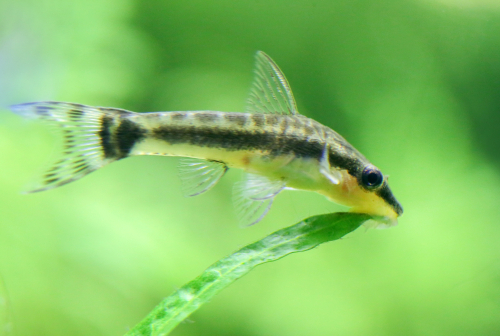
- Scientific Name: Otocinclus sp.
- Adult Size: 1 to 2 inches
- Compatible with: danios, corydoras, tetras, mollies, guppies
- Care Level: easy
- Origin: rivers and streams in South America
The otocinclus catfish is a small freshwater fish with a cylindrical body that comes in about 20 different species.
This fish has a very sweet and peaceful temperament which makes it one of the best tankmates for MBU puffer fish, South American puffers, and pea puffers.
Pros of keeping it with Puffer Fish
- Has a calm temperament and stays out of the way of territorial pufferfish
Cons of keeping it with Puffer Fish
- None!
2. Nerite Snail
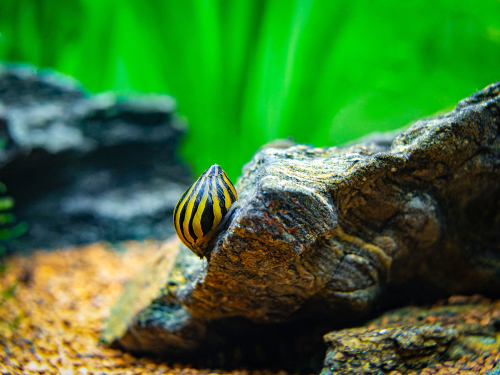
- Scientific Name: Vittina natalensis
- Adult Size: 1 inch
- Compatible with: guppies, cherry shrimp, neon tetras, barbs
- Care Level: easy
- Origin: Eastern Africa
The nerite snail is a small, freshwater or saltwater snail that belongs to the Neritidae family. These snails are popular among aquarium enthusiasts for their attractive shells.
Since nerite snails are peaceful creatures that mind their own business, they can be easily paired with most puffer species.
Pros of keeping it with Puffer Fish
- Are peaceful and keep to themselves
Cons of keeping it with Puffer Fish
- Some pufferfish species may nip at them
3. Clown Pleco
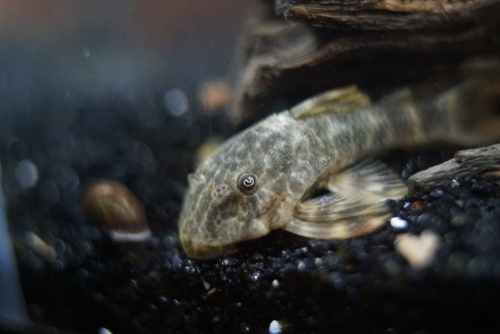
- Scientific Name: Panaqolus maccus
- Adult Size: up to 3.5 inches
- Compatible with: angelfish, corydoras, rasboras, dwarf gouramis
- Care Level: easy
- Origin: Colombia and Venezuela
Clown plecos are small, bottom-dwelling fish with colorful patterns on their bodies. Due to their unique appearance and algae-eating capabilities, they are very popular in the aquarium trade.
Clown plecos make excellent tankmates for puffers such as the MBU pufferfish due to their peaceful nature.
Pros of keeping it with Puffer Fish
- Swim fast and keep to themselves
Cons of keeping it with Puffer Fish
- Other species of pufferfish can harm them
4. Kuhli Loach

- Scientific Name: Pangio kuhlii
- Adult Size: 3 to 4 inches
- Compatible with: mollies, corydoras, guppies, rasboras
- Care Level: easy
- Origin: Southeast Asia, especially Indonesia, and Malaysia
Kuhli loaches are small, bottom-dwelling fish with thin, nearly cylindrical bodies. These eel-like bodies are covered with dark brown or black bands.
Since kuhli loaches like to dwell at the bottom of the tank and stay out of the way of other fish, they make ideal tankmates for the South American puffer and the pea puffer.
Pros of keeping it with Puffer Fish
- Are peaceful and stay out of the way of puffers
Cons of keeping it with Puffer Fish
- None!
5. Fancy Guppy
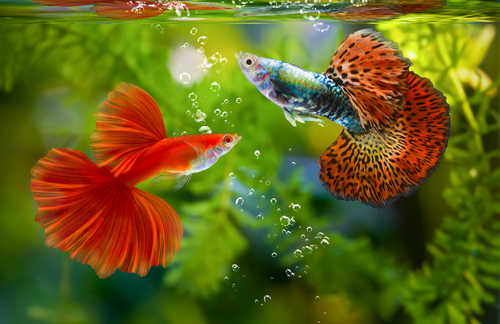
- Scientific Name: Poecilia reticulata
- Adult Size: 1 to 2 inches
- Compatible with: mollies, platies, neon tetras
- Care Level: easy
- Origin: northeast South America
Fancy guppies are small tropical fish found in freshwater streams in South America. These colorful fish are hugely popular in the aquarium trade due to their peaceful nature and beautiful appearance.
Due to their small size and peaceful temperament, fancy guppies can be suitable tankmates for the MBU pufferfish.
Pros of keeping it with Puffer Fish
- Peaceful nature
Cons of keeping it with Puffer Fish
- MBU puffers might become aggressive and nip at their fins when feeding
6. Corydoras
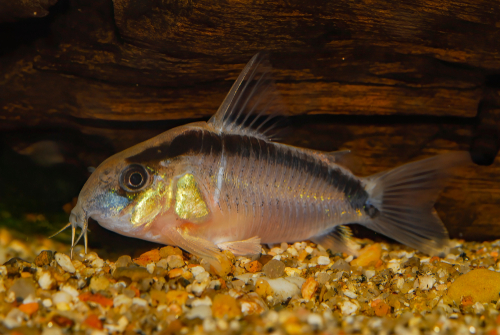
- Scientific Name: Corydoras
- Adult Size: 1 to 4 inches
- Compatible with: swordtails, mollies, guppies, and tetras
- Care Level: easy
- Origin: freshwater bodies in South America
Corydoras are yet another popular type of aquarium fish that share quite a few similarities with clown plecos in terms of appearance though they have shorter fins.
Since they are peaceful, bottom-dwelling fish, corydoras can be good tankmates for pea puffers, MBU puffers, and South American puffers.
Pros of keeping it with Puffer Fish
- Are peaceful and dwell at the bottom
Cons of keeping it with Puffer Fish
- Having many corydoras in the tank might make puffers hostile
7. Rasboras
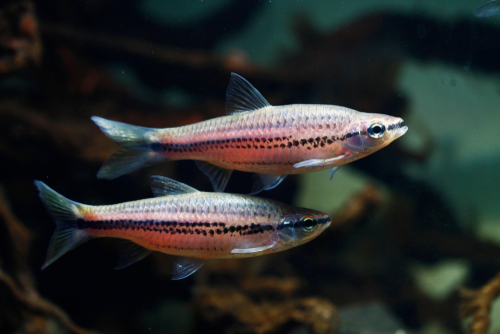
- Scientific Name: Rasbora
- Adult Size: about 2 inches
- Compatible with: small tetras, celestial danios, guppies, and other rasboras
- Care Level: easy
- Origin: freshwater rivers and streams in South and Southeast Asia
Rasboras are small, colorful schooling fish that are perfect for small and medium-sized aquariums. They are quite easy to care for and get along well with other similarly-sized community fish.
Due to their calm and easygoing nature, rasboras can co-exist peacefully with MBU puffers and red-tailed dwarf puffers.
Pros of keeping it with Puffer Fish
- Are fast and active and stay out of the puffers’ way
Cons of keeping it with Puffer Fish
- MBU puffers can sometimes prey on rasboras if there’s no foliage and other hiding spaces
8. Mollies
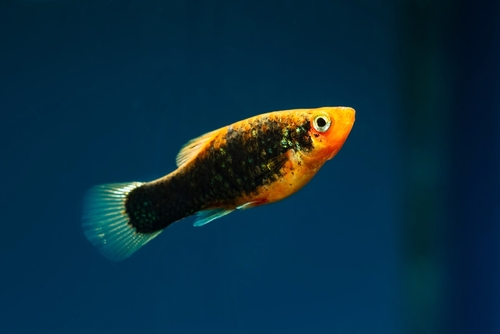
- Scientific Name: Poecilia sp.
- Adult Size: 3.5 to 6 inches
- Compatible with: neon tetras, dwarf cichlids, tiger barbs, cardinal tetras
- Care Level: easy
- Origin: southern North America, especially Mexico
Mollies are some of the most popular fish in the aquarium trade and are simply loved by aquarists. In terms of appearance, you’ll find several varieties of the fish and red, orange, and yellow are the most common body colors (common molly).
Mollies are incredibly easy to care for, have a generally peaceful temperament, and get along well with pea puffers.
Pros of keeping it with Puffer Fish
- Peaceful temperament
Cons of keeping it with Puffer Fish
- None!
9. Bumblebee Goby
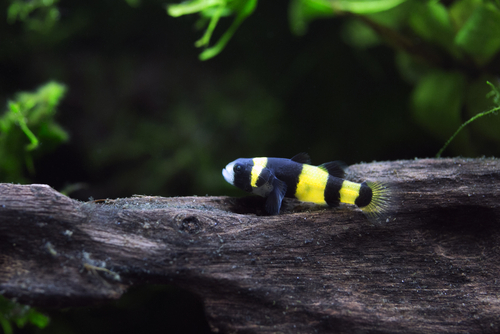
- Scientific Name: Brachygobius xanthomelas
- Adult Size: about 1.5 inches
- Compatible with: mollies, guppies, and nerite snails
- Care Level: intermediate to difficult
- Origin: Southeast Asia (Vietnam, Thailand, Indonesia)
Bumblebee gobies are highly sought after by aquarium enthusiasts due to their unique appearance and interesting behavior. They are known for their striking black and yellow striped patterns, which resemble the colors of a bumblebee.
Their peaceful nature makes them suitable tankmates for pufferfish.
Pros of keeping it with Puffer Fish
- Are peaceful and shy
Cons of keeping it with Puffer Fish
- None!
10. Neon Tetra

- Scientific Name: Paracheirodon innesi
- Adult Size: about 1.5 inches
- Compatible with: rasboras, dwarf gouramis, small catfish
- Care Level: intermediate
- Origin: Amazon basin in South America
Neon tetras are small, colorful freshwater fish that are popular among aquarium hobbyists for their vibrant and eye-catching colors.
These fish are relatively peaceful and non-aggressive, making them suitable for community aquariums and as tankmates for pufferfish.
Pros of keeping it with Puffer Fish
- Are active and peaceful fish
Cons of keeping it with Puffer Fish
- None!
11. Danios
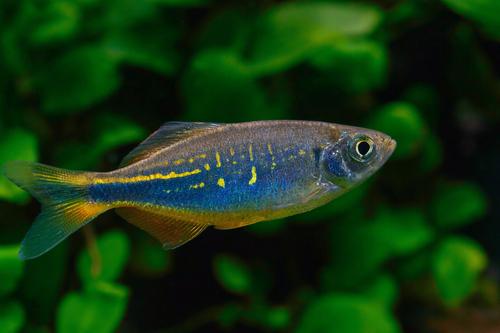
- Scientific Name: Danio
- Adult Size: 2 to 4 inches
- Compatible with: mollies, tetras, platies, small barbs, swordtails
- Care Level: easy
- Origin: South and Southeast Asia
Danios are a group of small freshwater fish belonging to the genus Danio. They are popular among aquarium enthusiasts due to their active nature, striking colors, and ease of care.
Due to their mostly peaceful nature, danios can get along well with most pufferfish species, except the MBU puffer which can be too big for them.
Pros of keeping it with Puffer Fish
- Get along with most puffer breeds
Cons of keeping it with Puffer Fish
- Keeping danios with MBU puffers can create problems
12. Siamese algae eater

- Scientific Name: Crossocheilus oblongus
- Adult Size: up to 6 inches
- Compatible with: dwarf cichlids, barbs, gouramis, catfish
- Care Level: easy
- Origin: Southeast Asia
Siamese algae eaters are popular aquarium fish known for their ability to help control algae growth in tanks. They have a sucker-like mouth, which they use to scrape algae off surfaces.
These fish are docile and peaceful in nature and rarely show aggression. Due to this, they can be suitable tankmates for MBU puffers.
Pros of keeping it with Puffer Fish
- Are peaceful, docile, and community-loving fish
Cons of keeping it with Puffer Fish
- None!
13. Cherry Shrimp
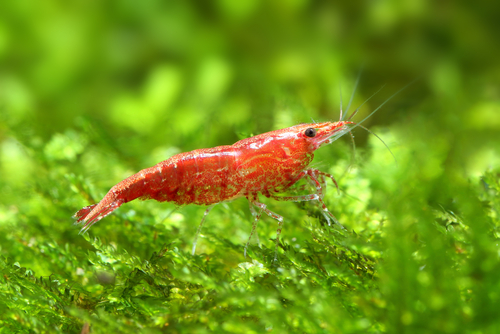
- Scientific Name: Neocaridina davidi
- Adult Size: 1 to 1.25 inches
- Compatible with: neon tetras, aquarium snails, amano shrimp, otocinclus catfish
- Care Level: intermediate
- Origin: Taiwan
Cherry shrimp are named for their bright red coloration, which is their most recognizable feature. However, through selective breeding, various color variations have been developed.
Although cherry shrimp are quite small in size, they make good tankmates for most puffer species, especially the pea puffer.
Pros of keeping it with Puffer Fish
- Are peaceful and keep to themselves at the bottom
Cons of keeping it with Puffer Fish
- None!
14. Platies
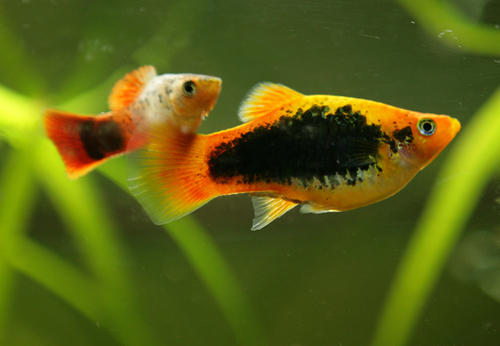
- Scientific Name: Xiphophorus maculatus
- Adult Size: up to 3 inches
- Compatible with: small tetras, corydoras, tetras, rainbowfish
- Care Level: easy
- Origin: Central and South America,
Platies are small freshwater fish having a compact and laterally compressed body shape. They come in a variety of colors, including red, orange, yellow, blue, and black, with different patterns and combinations.
Their peaceful and sociable nature makes them suitable tankmates for small puffer species such as pea puffers.
Pros of keeping it with Puffer Fish
- Are peaceful and get along well with other fish
Cons of keeping it with Puffer Fish
- None!
15. Killifish
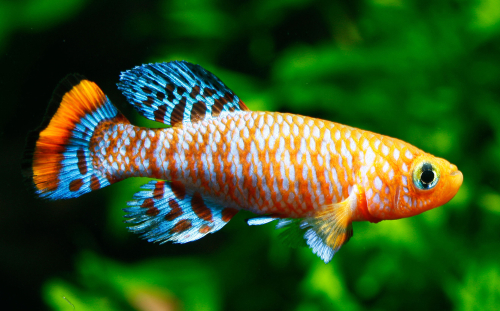
- Scientific Name: Cyprinodontidae
- Adult Size: 1 to 3 inches
- Compatible with: rasboras, danios, neon tetras, corydoras
- Care Level: easy to intermediate
- Origin: North and South America, Southeast Asia, and Africa
Killifish comprise a large family with over 1,250 recognized species, including both annual and non-annual varieties.
Due to their small size and non-aggressive temperament, killifish can co-exist peacefully with pea puffers and make ideal tankmates.
Pros of keeping it with Puffer Fish
- Have a peaceful and non-aggressive nature
Cons of keeping it with Puffer Fish
- Care should be taken to prevent any harm to killifish
Final Thoughts
In this guide, we explored the 15 best puffer fish tank mates you can get for your pufferfish and also explained the factors you need to consider when choosing them. Some of the best tankmates include tetras, clown plecos, fancy guppies, rasboras, platies, and danios.
We hope you found this guide helpful and insightful. Thank you for reading!

JJ has had a passion for learning about aquatic life since age 5. As an adult, he made his passion a career as a certified aquaculture dealer and aquarium content creator.


